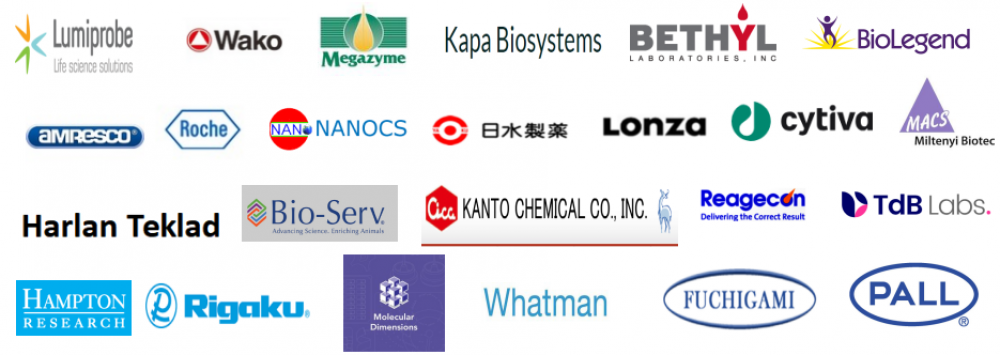Wako 125-05061 赖氨酰肽链内切酶使用说明书
质谱级赖氨酰肽链内切酶 Lysyl Endopeptidase
【产品详情】
赖氨酰肽链内切酶
品牌:WAKO
级别:质谱级
赖氨酰肽链内切酶Lysyl Endopeptidase 125-05061 wako
英文品名:Lysyl Endopeptidase?, Mass Spectrometry Grade
货号:125-05061
规格:5×20 μg
应用:蛋白质组学。
用途:赖氨酰肽链内切酶,蛋白测序、质谱分析,多肽合成
赖氨酰肽链内切酶Lysyl Endopeptidase 125-05061 wako
实验方法
1. 试剂:
A.0.2 mol/L AMP 缓冲液,pH值 9.5
溶解 4.2 g 的2-氨基-2-甲基-1,3-丙二醇于 150 mL 的水中,加入1 mol/L HCl 调 pH 值至 9.5,再加水使体积至 200 mL。
B.2.5 mmol/L 底物溶液
溶解 22.6 mg 的N-苯甲酰基-DL-精氨酰-4-硝基苯胺盐酸盐于 20 mL 水中。
C. 2 mmol/L Tris-HCl 缓冲液,pH8
溶解 0.24 mg的2-氨基-2-羟甲基-1,3-丙二醇于 900 mL 水中,加入 0.1 mol/L HCl 调pH值至8,再加水使体积至1 L。
D. 酶溶液
溶解1vial 的赖氨酰肽链内切酶于1mL 的溶剂C中,可直接加入。
E. 终止溶液
将 55 mL 水和 45 mL 乙酸混合均匀。
2. 步骤
| 试剂 | 检测样品 | 空白对照 |
| A | 2.6 mL | 2.6 mL |
| B | 0.3 mL | 0.3 mL |
| 30℃ 预培养5分钟 | ||
| D | 0.1 mL | – |
| C | – | 0.1 mL |
| 立即混合均匀,30℃ 预培养25分钟 | ||
| E | 1.0 mL | 1.0 mL |
3. 单位的定义
酰胺酶单位是指 30℃、pH 9.5 时,每分钟产生1μmol 对硝基苯胺的酶量。
AU/vial = [(a-b) / 25] × (1/9.62) × (4.0/0.1)
a. 检测样品中的吸光度
b. 空白对照中的吸光度
胶内酶切的实验操作流程
用聚硅酮处理的微量离心管和吸管端防止捕获任何蛋白。使用质谱分析用凝胶染色试剂盒,例如银染剂 MS 试剂盒(产品编号:299-58901)和负凝胶染色 MS 试剂盒(产品编号:293-57701)
1. 电泳分离蛋白质样品;
2. 从凝胶中切割蛋白质片断并放入微量离心管;
3. 使凝胶脱色(可使用质谱分析用凝胶染色试剂盒中的脱色溶液);
4. 加入300 μL 乙腈到试管里,搅拌器振荡 30 分钟;
5. 去除乙腈,用 Parafilm 膜覆盖微量离心管。
6. 在 Parafilm 膜上打出针孔,真空干燥 15 分钟;
7. 100 μL 10 mmol/L DTT 溶解于 100 mmol/L 碳酸氢铵,56℃恒温1小时。
8. 室温冷却后,用等量的 50 mM 碘乙酰胺溶解于 100 mmol/L 碳酸氢铵,暗处恒温 45 分钟并涡旋;
9. 用 100 μL 100 mmol/L 碳酸氢铵洗涤凝胶片段 10 分钟;
10. 用 300 μL 乙腈干燥凝胶片段 15 分钟;
11. 用 100 μL 100 mmol/L 碳酸氢铵溶胀凝胶片段 15 分钟;
12. 用 300 μL 乙腈再次干燥凝胶片段 15 分钟;
13. 去除液相,真空干燥凝胶片段 15 分钟;
14. 用 100 μL 赖氨酸内切酶溶液*在冰水浴中溶胀凝胶片段 45 分钟;
*赖氨酸内切酶稀释于 50 mmol/L Tris-HCl pH 8.5;
15. 去除 100 μL 赖氨酸内切酶溶液,将凝胶片段放在 37℃、10 μL 50 mmol/L Tris-HCl pH 8.5 中过夜;
16. 加入 50 μL 20mmol/L 碳酸氢铵 20 分钟内振荡凝胶片段3次抽提多肽;
17. 加入 5% 甲酸/50% 乙腈 20 分钟内振荡凝胶片段3次抽提多肽;
18. 如果需要用 Speed Vac. 浓缩多肽;
19. 用 ZipTip 脱盐和纯化多肽;
20. 如果需要用弱真空浓缩多肽至2 μL;
21. 加入基质进行质谱分析。
注意:根据细菌的生理和形态特征分类,产品来源为水解无色杆菌,但是最近细菌分类学将这种细菌鉴定为产酶溶杆菌。
保存:暗处-20℃保存
规格:20 μg×5 vial
Wako 125-05061 赖氨酰肽链内切酶使用说明书 参考文献
[1] Ojima T et al. “Characterization of Halomonas Sp. Strain H11 {alpha}-Glucosidase Activated by Monovalent Cations and Its Application for Efficient Synthesis of {alpha}-D-Glucosylglycerol.” Applied and Environmental Microbiology 78, no. 6 (March 15, 2012): 1836–1845.
[2] Leitner A et al. “Expanding the Chemical Cross-Linking Toolbox by the Use of Multiple Proteases and Enrichment by Size Exclusion Chromatography.”Molecular and Cellular Proteomics 11, no. 3 (March 1, 2012): M111.014126.
[3] Goetze A et al. “Rates and Impact of Human Antibody Glycation in Vivo.” Glycobiology 22, no. 2 (February 1, 2012): 221–234.
[4] Thingholm, T et al. “Characterization of Human Myotubes From Type 2 Diabetic and Nondiabetic Subjects Using Complementary Quantitative Mass Spectrometric Methods.” Molecular and Cellular Proteomics 10, no. 9 (September 1, 2011): M110.006650.
[5] Shoji M et al. “walK and clpP Mutations Confer Reduced Vancomycin Susceptibility in Staphylococcus Aureus.” Antimicrobial Agents and Chemotherapy 55, no. 8 (August 1, 2011): 3870–3881.
[6] Kubota T et al. “Quantitative Proteomic Analysis of Chromatin Reveals That Ctf18 Acts in the DNA Replication Checkpoint.”Molecular and Cellular Proteomics 10, no. 7 (July 1, 2011): M110.005561.
[7] Lee E et al. “The Steady-State Repertoire of Human SCF Ubiquitin Ligase Complexes Does Not Require Ongoing Nedd8 Conjugation.” Molecular and Cellular Proteomics 10, no. 5 (May 1, 2011): M110.006460.
[8] Shirai Y et al. “Direct Binding of RalA to PKC{eta} and Its Crucial Role in Morphological Change During Keratinocyte Differentiation.” Molecular Biology of the Cell 22, no. 8 (April 15, 2011): 1340–1352.
[9] Liu D et al. “N-terminal Glutamate to Pyroglutamate Conversion in Vivo for Human IgG2 Antibodies.” Journal of Biological Chemistry 286, no. 13 (April 1, 2011): 11211–11217.
[10] Shen H et al. “Constitutive Activated Cdc42-associated Kinase (Ack) Phosphorylation at Arrested Endocytic Clathrin-coated Pits of Cells That Lack Dynamin.” Molecular Biology of the Cell 22, no. 4 (February 15, 2011): 493–502.
[11] Keinath N et al. “PAMP (Pathogen-associated Molecular Pattern)-induced Changes in Plasma Membrane Compartmentalization Reveal Novel Components of Plant Immunity.” Journal of Biological Chemistry 285, no. 50 (December 10, 2010): 39140–39149.
[12] Maeda T et al. “Purification, Characterization and Amino Acid Sequence of a Novel Enzyme, D-threo-3-hydroxyaspartate Dehydratase, from Delftia Sp. HT23.” Journal of Biochemistry 148, no. 6 (December 1, 2010): 705–712.
[13] Rajagopal C et al. “Secretion Stimulates Intramembrane Proteolysis of a Secretory Granule Membrane Enzyme.” Journal of Biological Chemistry 285, no. 45 (November 5, 2010): 34632–34642.
[14] Sato H et al.“Novel Isonitrile Hydratase Involved in Isonitrile Metabolism.”Journal of Biological Chemistry 285, no. 45 (November 5, 2010): 34793–34802.
[15] Manno S et al. “ATP-dependent Mechanism Protects Spectrin Against Glycation in Human Erythrocytes.” Journal of Biological Chemistry 285, no. 44 (October 29, 2010): 33923–33929.
[16] Matsumoto T et al. “Proteomic Analysis Identifies Insulin-like Growth Factor-binding Protein-related Protein-1 as a Podocyte Product.” Renal Physiology 299, no. 4 (October 1, 2010): F776–784.
[17] Sury M et al. “The SILAC Fly Allows for Accurate Protein Quantification in Vivo.” Molecular and Cellular Proteomics 9, no. 10 (October 1, 2010): 2173–2183.
| 产品编号 | 产品名称 | 产品规格 | 产品等级 |
| 125-05061 | Lysyl Endopeptidase®, MS Grade 赖氨酰肽链内切酶,MS级 |
20 μg×5 | 质谱级 |
相关产品
| 产品编号 | 产品名称 | 包装 | 应用 |
| 202-15951 | Trypsin, from Porcine Pancreas,
Mass Spectrometry Grade 猪胰腺胰蛋白酶质谱级别 |
5×20 μg | 蛋白质组学 |
| 056-05921 | Endoproteinase Asp-N, Sequencing grade 胞内蛋白酶 Asp-N(测序级别) |
2 μg | 用于测序 |
| 050-05941 | Endoproteinase Glu-C, Sequencing grade 胞内蛋白酶 Glu-C(测序级别) |
50 μg | |
| 164-13982 | V8 Protease [Endoproteinase Glu-C] V8蛋白酶 |
2 mg | 生物化学 |
